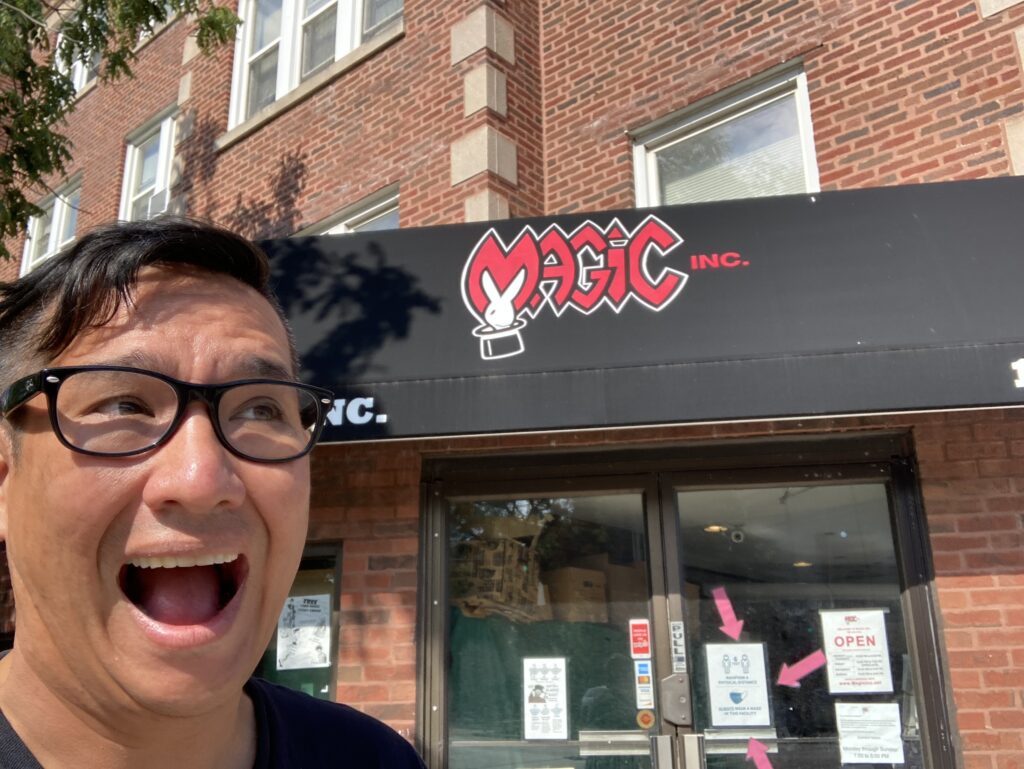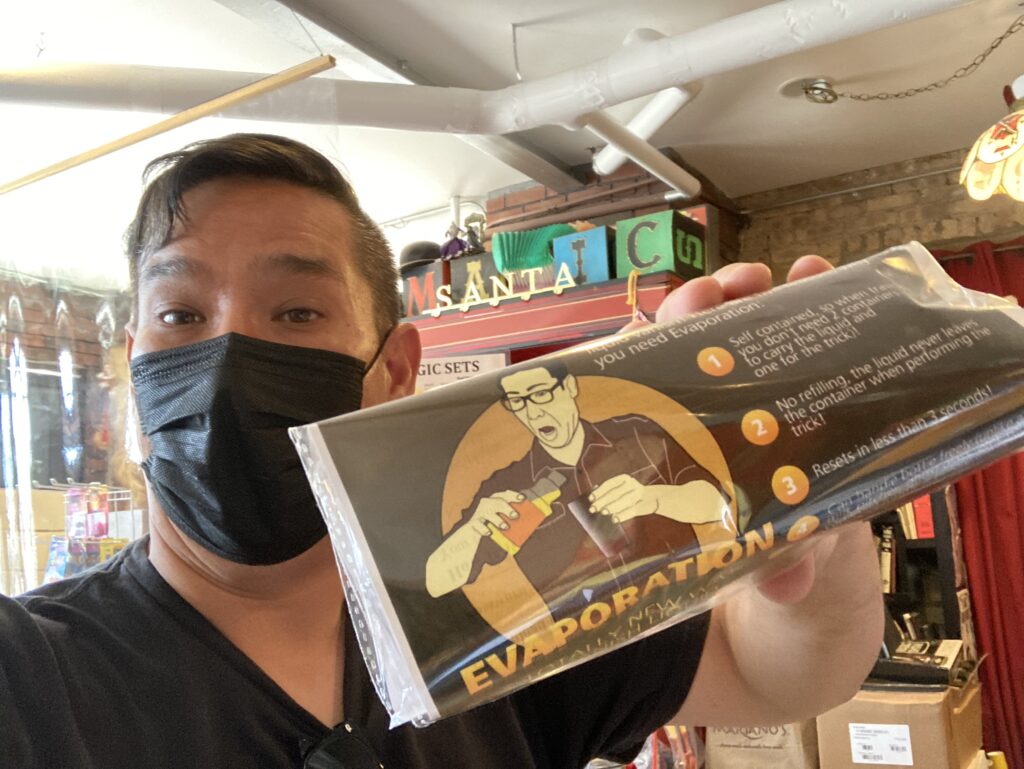In the past I’ve played with using an invisible deck in my show. The issue I have with it, is that it’s a pretty standard trick. I want to layer it with having something more than just an upside down card. In the past I’ve come up with a method where you can have more than one card picked (no force) and they are all upside down. In my show right now I’m using a variation on Vernet Magic’s 52 B’wave.
The 52 B’wave effect is the named card is upside down, has a different colored back and all of the other cards are blank. I really like this effect, and I think a booker that has seen the invisible deck will be able to tell the difference. What I don’t like about it is that there is a force of the color of the card.
I was kicking around ideas for it, and I think I have come up with a method that I like better than Vernet’s 52 B’wave. Here’s how the effect will play, you show a deck of cards and hold half in each hand. The audience chooses a half to eliminate (no forces are used in this) and you put them on the table. You then split the remaining cards in and half chosen to eliminate and repeat this till you have one card. The elimination process happens with the faces of the cards to the audience. You then reach into your pocket and remove a deck of cards. Inside that deck is one face up card, it matches the one selected by the audience. The card is not only the only card face up, but it has a different colored back, and the rest of the deck is blank! Not that I would do this, but at the end of the trick, the deck is ungimmicked and could be examined.
OK, for method it’s a combination of a gimmick, and sleight of hand. I haven’t tried this yet, but I’ll going to give it a go during my preshow at the fair tomorrow!
-Louie
Tag: card trick
It’s a Joke-r…
Here’s another one of my videos where I try to improve packet tricks that I’ve come across. This one is called It’s a Joke-r by Bill Pryor. Here’s the video of it done with the original instructions and then a revised version for a real audience:
The trick is sort of a Princess Card Trick with a kicker, but it’s poorly executed. The whole part of putting a card in your pocket, just to pull it out I don’t like. I also don’t like waiting for the audience to want to turn over the cards on the table for the kicker to happen. If they do turn them over, it’s great, but if they don’t, the trick is just OK.
The changes I made of have a card thought of by me and the person from the audience gives the trick a little more depth. Then never putting a card in my pocket, but keeping it in my hand adds a lot to the trick. Finally having a reason for them to turn over the cards to discover the jokers guarantees they get revealed.
This is a trick that takes up way too much pocket space for how good the trick is. I don’t think the original or my revised version justifies the use of space.
More Jumping Torn and Restored Card…
Last week I did a blog post about a torn card trick (read it here) and I had a chance to do some work on it and try to improve it. I eliminated the use of the Intersessor gimmick, as it made the trick more complex because I had to ditch it, and it’s not easy to palm.
Here’s the second version:
I think this is a better way to do it, and it got a good reaction.
I’ve been working on my technique for making the card jump out and it’s getting better. I’m consistently getting bigger jumps of the card from the deck. What’s missing is the effect. Right not it’s now clear what’s going on. I also need to figure out a better way to vanish the torn pieces.
Hopefully I’ll have a version 3 soon-ish
Ghost Cards…
This is a packet trick revision of a trick called Ghost Cards. The following video has me do the trick as written in the instructions, followed by me trying to improve it.
The main problem with the trick as written is that there’s a lot of props and procedure to make one side of one card appear. In my revised version you can make four faces appear, which makes much more sense than just one. While not in the video, you can reverse the procedure to make the cards disappear at the end.
This is a trick that snuck into my close up set at the fair I recorded the video at. I forgot to take it out of my pocket the first day, and it lived there all week and I did it all week. It was fun, and I did it for people who had seen me multiple times as something different for them, but it’s not making it into the regular set.
Torn Corner…
Personally I dislike using a torn corner to identify a card or bill. It’s very clunky compared to having is signed and you lose the punch of the item reappearing and having it immediately identifiable.
Ok, that’s out of the way, now I’m doing to explain why I’m playing with a trick with a torn corner.
A long time ago when Gaeton Bloom’s Intersessor trick came out, I thought it would lend itself to a trick in Tarbell where a card jumps out of the deck when the end is riffled. I never did it because $50 to play with an idea that I would probably never use was a bit steep. Recently I found a super deal on a used Intersessor gimmick and bought it.
Here’s me trying out the idea before my show and my comments on it:
I think I’m going to switch it up and use a corner switch or a scored duplicate card instead of the Intersessor gimmick. That will solve having to ditch the gimmick. With scored card or corner switch, it will allow me to use a bigger tear which will let me do a bigger tear and get a bigger jump of the card.
Magic Inc!
I’ve wanted to visit Magic Inc for a long time, however every time I’ve been in Chicago it’s been closed. I finally made it to Chicago when it was open.

Inside I noticed they had my Evaporation trick in stock! It’s always fun to see my trick out there in magic shops.

While I was there I picked up a copy of Theseus by Nathan Colwell.

It’s an interesting idea, it’s basically a book that’s just one trick, with a lot of methods for it. It sounds like it’s a bit of a journey through how the trick was created. I haven’t really had a chance to dig into it yet, but I’m excited to read it!
Freedom of the Seize…
The other day my buddy Matt Disero posted on his Facebook about a Stewart James trick that he thought was overlooked by magicians. I’m a huge Stewart James fan, and dug out the book and read the trick. It’s on page 120 of Stewart James In Print: The First Fifty Years

In the introduction to the trick it says that it’s not a good trick for non-magicians, but a fooler for magicians. I think whoever wrote that intro was correct, well for how the trick was written up. It’s a very interesting principle, here’s the effect:
Someone picks a card and puts it face up on top of the deck. The cards are cut to bury the card. You then take the cards behind your back tell them the card above the face up card.
It’s very clever, and I think it has a use in a longer routine. As a stand alone, I’m not sure how I feel about it…
Alexa’s Aces
Awhile ago I wrote about a card trick I was working on that used an Amazon Alexa for the reveal (you can read the blog posts here and here). Here’s some video of it in action:
It’s a good novelty reveal, the weak spot for me is that I have to briefly see the aces at the beginning. I wanted a trick that would work start to finish without me having to see anything. I came up with the solution. It’s a 100% self working, you wouldn’t need to be in the room for the trick to work. I’ll write about it another time.
Working On It…
A couple of weeks ago I got to do my Polaroid Trick for an in person audience. I did it using video projection and it played well. Here’s what it looked like:
Here’s my notes:
- The lighting needs to be better. It cuts off my face.
- Some light background music would help it.
- 0:26 mark: hold for the laugh a little bit longer
- 1:27 mark: freeze and stop moving during the applause
- 1:47 mark: pause another beat or two between the vanish and reproduction of the picture
- 1:52 mark: applause is starting and I step on it by going to my next line
So what I need to work on is mostly timing things, and letting effects and the reactions “marinade” a bit longer with the audience.
Spreading Stuart Gordon…
In yesterday’s blog post I mentioned the Stuart Gordon Double Turnover and that you should learn it, even if you never do it in a show. I think knowing different double lifts is handy so that when you do need one you can vary your technique or choose the right one for the situation. That goes with most sleight of hand, knowing different ways to accomplish the same action makes you a much better artist.
Recently I’ve been playing with the action of the Stuart Gordon Double Turnover, but not as a double turnover, but as a display of two cards. In the action of displaying and fanning the cards I’m able to hide a card. Technically it’s a three as two display in a fan.
The problem I had with it was besides it being very “knacky” it really didn’t provide an advantage over existing moves. I was jamming with Jonathan Friedman and Chris Beason and showed them the move. We really couldn’t come up with much besides using it to switch one or two cards. There are a lot of better ways to switch a card or two.
I kept playing with it and worked out a sequence for the move. Here’s a rough version of it, it’s pretty clunky and I’ve cleaned up the final get ready since I made this video.
Here’s the routine:
I’m not sure that a two card simultaneous ambitious card is better than with a single card, but it gives the move a purpose.
